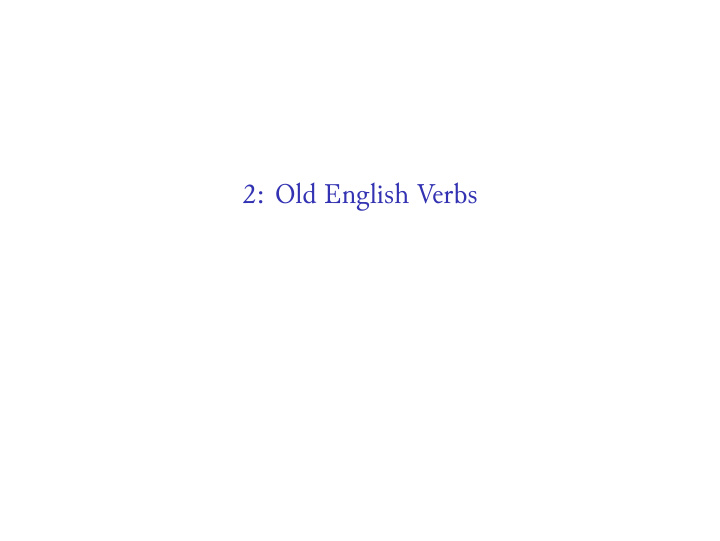



2: Old English Verbs
Verb Classes Strong Form their preterites and past participles using vowel gradation: singan, sang, sungon, sungen Weak Form their preterites and past participles by adding a dental suffix d/t : lǣran, lǣrde, lǣrdon, lǣred Anomalous/Mixed Do not answer to these categories, or combine them. All verb classes commonly prefix the past ptc. with ge- : gesungen, gelǣred
Conjugation ▶ Person: first, second, third ▶ Number: singular, plural ▶ Tense: present, preterite ▶ Mood: indicative, subjunctive, imperative ic fremme wē fremmað þū fremest gē fremmað hē fremeð hīe fremmað Cf. early Modern English ‘I do, thou dost, he doth’.
Conjugation ▶ Person: first, second, third ▶ Number: singular, plural ▶ Tense: present, preterite ▶ Mood: indicative, subjunctive, imperative ic fremme wē fremmað þū fremest gē fremmað hē fremeð hīe fremmað ! Einheitsplural : contrast wir machen/tun, ihr macht/tut
Tense ▶ OE present : MnE present, future (simple/continuous); ▶ OE preterite : MnE past, present perfect, past perfect (simple/continuous); ▶ resolved tenses: habban / bēon /modal + participle/infinitive. (= periphrastic tenses) ic fremme ic fremede ic hæbbe gefremed ic hæfde gefremed þæt wæs gefremed hē sceal fremman is fela tō fremmenne
Conjugation ▶ Person: first, second, third ▶ Number: singular, plural ▶ Tense: present, preterite ▶ Mood: indicative, subjunctive, imperative Weak Strong ic fremme wē fremmað ic scīne wē scīnað þū fremest gē fremmað þū scīnest gē scīnað hē fremeð hīe fremmað hē scīneð hīe scīnað ic fremede wē fremedon ic scān wē scinon þū fremedest gē fremedon þū scine gē scinon hē fremede hīe fremedon hē scān hīe scinon
Strong Verb Gradation Patterns class first fronted second third fourth cf. 1 scīnan scān scinon scinen write/scheinen 2 crēopan crīepþ crēap crupon cropen freeze/frieren 3 bregdan britt brægd brugdon brogden bind/bergen 4 beran birþ bær bǣron boren bear/gebären 5 tredan tritt træd trǣdon treden tread/treten 6 faran færst fōr fōron faren shake/fahren 7 healdan healdeþ hēold hēoldon healden fall/halten 7 grow/hātan hǣt hēt hēton hāten heißen
Strong Verb Gradation Patterns class first fronted second third fourth 1 ī ā i i 2 ēo īe ēa u o 3 eCC iCC æCC uCC oCC 4 e i æ ǣ o 5 e i æ ǣ e 6 a æ ō ō a 7 X X-fronted Y Y X
Conjugation ▶ Person: first, second, third ▶ Number: singular, plural ▶ Tense: present, preterite ▶ Mood: indicative, subjunctive, imperative Hēo fremeþ þæt Ic wille, þæt hēo fremme þæt (cf. ‘that she do that’) Ic wille, þæt wē fremmen þæt Ic wolde, þæt hēo fremede þæt Ic wolde, þæt wē fremeden þæt Freme þæt! Fremmaþ þæt! → See subjunctive handout
Voice No inflectional passive. Passivity is expressed: ▶ Through bēon or weorðan + past participle: Hē wearð ācenned Se cāsere wæs ofslagen ▶ Through impersonal man with an active verb: Man brohte his hēafod on ānum disce Man gehalgode twēgen biscopas Only the verb hātan can be used as a true passive verb: Saga hwæt ic hātte (Cf. Sum consul Boetius wæs hāten , formed with bēon .)
Anomalous Verbs
Recommend
More recommend